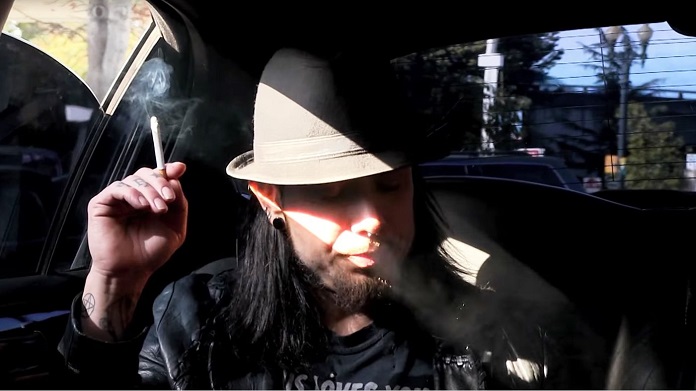
Mourning Son
Studio: Vega Baby
Directed by Todd Newman
Dec 02, 2015
Web Exclusive
![]()
For as much as there is beauty in pain, there is a darkness that grows from holding on to it. While Dave Navarro has built a career exploring those contrasts—his body covered in colorful tattoos, his hobbies including suspension and his heartfelt compositions for bands like Jane’s Addiction offering a musical compass that directed much of the ‘90s rock epoch—few know the prologue that became its incubator.
In 1983, when Navarro was just 15 years old, his mother Constance and her good friend Sue Jory were brutally murdered by the former’s abusive con-artist ex-boyfriend, John Riccardi. It was an event that “changed everything,” Navarro admits at the onset of “Mourning Son,” a documentary he produced with his director friend Todd Newman, which explores the crime and its vast implications.
“It was an excuse to get away with anything,” furthers Navarro, recusing himself of his failed relationships, morbid curiosities and years of drug abuse that began on the day of Connie’s death—a day that Navarro says he should’ve been killed as well if he had not made the decision to stay at his father’s house that night. That innate sense of fear he felt in the beginning continued to multiply each of the nearly 10 years Riccardi remained on the lam until a feature on “America’s Most Wanted” and tips from plastic surgeons resulted in his capture and death penalty conviction.
“Mourning Son” does well to cover most corners of the story and the people behind it. “They say the death of one person affects 10,000 lives,” says cousin Dan Navarro, half of the musical act Lowen & Navarro, who takes up a good amount of screen time. So does Navarro’s father, Michael, childhood friend and Jane’s drummer Stephen Perkins, various neighbors and the prosecutor and reporters covering the court case. The intimate interviews are interspersed with home video archives, some of Connie’s old promo reels showing her past as a game show model and a beautiful assortment of art-house films made by Navarro over the years that, at times, stylize the film into one provocative music video, sweetly connecting his mother to his current life she never got to experience.
Though Navarro and Newman joke early on in the film that they are “exploiting on riding the coattails of pain,” the film quickly serves to negate that idea. It’s evidenced in the moment when Navarro—nearly 30 years later—decides to visit Riccardi in prison. Though the cameras are not allowed, the visible horror on Navarro’s face after tells enough. It’s spoken of in his diligence of working with domestic violence groups like NOW and Linda’s Voice, declaring, “The goal is to be able to say to people to do something about it.” And ultimately it’s believed in the film’s ending moments as a painter recreates Connie’s portrait in Navarro’s own blood as he watches on, Elliott Smith’s “Fond Farewell to a Friend” playing in the background. “This was the last door or fear I had to walk through,” he says of making the film, which he admits resulted in a rebirth of his relationship with his mother and a new, important contrast to explore—even in death, there can be life.
Author rating: 7/10
Average reader rating: 8/10
Current Issue

Issue #72
Apr 19, 2024 Issue #72 - The ‘90s Issue with The Cardigans and Thurston Moore
Most Recent
- Under the Radar Announces The ’90s Issue with The Cardigans and Thurston Moore on the Covers (News) — The Cardigans, Thurston Moore, Sonic Youth, Garbage, The Cranberries, Pavement, Lisa Loeb, Supergrass, Spiritualized, Lush, Miki Berenyi, Miki Berenyi Trio, Emma Anderson, Hatchie, Ride, Slowdive, Velocity Girl, Penelope Spheeris, Terry Gilliam, Gus Van Sant, Ron Underwood, Kula Shaker, Salad, Foals, Semisonic, The Boo Radleys, Stereo MC’s, Pale Saints, Blonde Redhead, Sleater-Kinney, Cocteau Twins, Lucy Dacus, Alex Lahey, Horsegirl, Grandaddy, alt-J, Squid, The Natvral, Wolf Alice, Jess Williamson, Sunflower Bean, Orville Peck, Joel McHale
- 10 Best Songs of the Week: Fontaines D.C., Cassandra Jenkins, Loma, John Grant, and More (News) — Songs of the Week, Fontaines D.C., Cassandra Jenkins, Loma, John Grant, Good Looks, Hana Vu, Belle and Sebastian, Yannis & The Yaw, Strand of Oaks, Home Counties
- Fresh Shares New EP ‘Merch Girl’ (News) — Fresh
- Premiere: LOVECOLOR Shares New Video for “Crazy Love” (News) — LOVECOLOR
- Final Summer (Review) — Cloud Nothings

Comments
Submit your comment
June 20th 2021
3:39am
That innate sense of fear he felt in the beginning continued to multiply each of the nearly 10 years Riccardi remained on the lam.
https://califasthomebuyers.com/